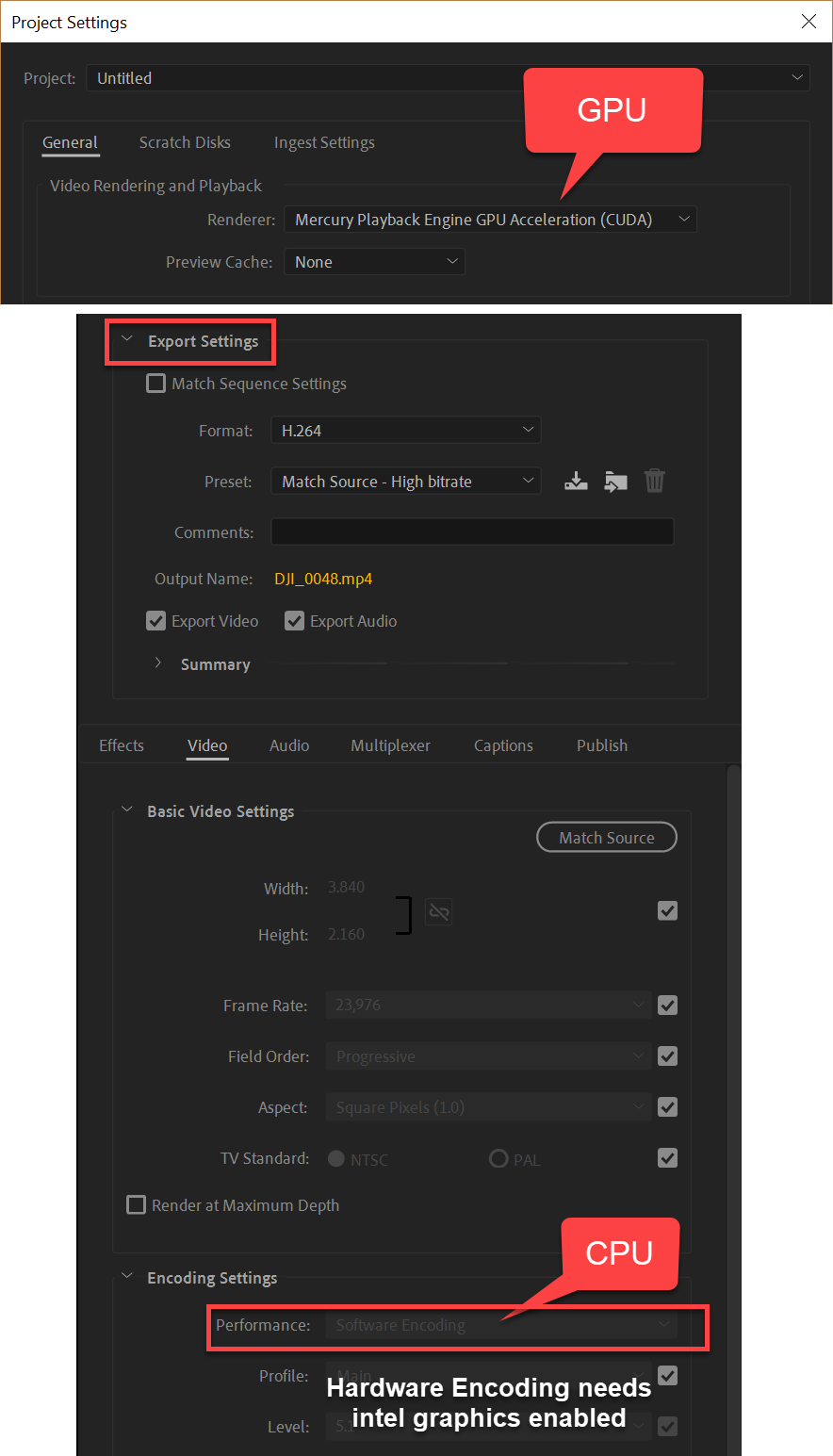- Home
- Premiere Pro
- Discussions
- Hardware Encoding or Acceleration Not Available
- Hardware Encoding or Acceleration Not Available
Hardware Encoding or Acceleration Not Available
Copy link to clipboard
Copied
Hi everyone,
I recently upgraded to a new gaming laptop with the following specs:
Intel(R) Core(TM) i7-8750H CPU @ 2.20GHz
NVIDIA GeForce GTX 1060
16 GB RAM
When I try to export my project as an MP4 file, under Encoding Settings in Performance, the box is grayed out and "Software Encoding" is selected by default. I'm not able to change it and it says Hardware encoding is not available and that my hardware or OS requirements might be out of date. My Intel does support Intel Quick Sync and I'm not sure why these options are not available. Please let me know what I can do to get these settings on here. Thanks for reading!

Copy link to clipboard
Copied
Hi OmerGuac,
If you scroll down from where your screenshot leaves off, are you on VBR, 1 Pass or VBR, 2 Pass? If you switch it to VBR, 1 Pass, does the Hardware Encoding option become available?
Copy link to clipboard
Copied
Hi Brandon,
I had it on VBR, 2 pass. I tried selecting 1 pass and CBR as well and they're still grayed out with Software Encoding defaulted.
Copy link to clipboard
Copied
Hmm, unless I'm overlooking something, I would think the same thing. I just checked your Intel Processor for QuickSync here: Intel® Product Specification Advanced Search), and I see your laptop listed. I just found a link, and I'll copy/paste a section that you can focus your attention to.
"If your Windows or Mac computer has one of those listed CPUs installed, the next thing to check is whether your motherboard allows you to simultaneously enable the internal Intel graphics driver, and any dedicated GPU (such as GeForce or Radeon). By default, the BIOS of most motherboards (a configuration screen you can access before booting into the OS) sets internal graphics to “Auto,” which actually means that if you have a dedicated GPU installed, Intel UHD/HD Graphics gets disabled. Some (but not all) motherboards allow you to force-enable internal graphics, and then it’s possible — though not guaranteed — you can boot into the OS with both internal and dedicated graphics acceleration active at the same time."
(Adobe Premiere Pro April 2018 Update: 2x faster export! | FocusPulling (.com))
Does this by chance help at all?
Copy link to clipboard
Copied
I think that your problem is that your particular laptop has the integrated Intel UHD Graphics disabled at the factory that manufactured the laptop. Therefore, there is no QuickSync, and thus no hardware acceleration. On the other hand, most laptops with this combo have both the integrated Intel UHD Graphics and the discrete GPU enabled.
Copy link to clipboard
Copied
Thanks, but now I just need to find out how to enable the Intel Quick Sync. I’ll contact HP today.
Copy link to clipboard
Copied
Did you ever have any luck with this? Did you try contacting HP?
Copy link to clipboard
Copied
I contacted them and they said that mine has Nvidia so why would it matter? I told them I want to enable quick sync and that the intel graphics control panel is not visible when right clicking the desktop. Then they told me that we don’t enable it because I have nvidia, yet my Acer has both enabled with no issue. I’m not too happy with HP so I’m sucking it up with software encoding for now. I’m aware that my CPU will reach 100% no matter what, but its going to be doing that even longer than it would with hardware options.
Copy link to clipboard
Copied
Same boat 😕
Copy link to clipboard
Copied
Follow these steps :-
1. Download Latest Nvidia driver and install it ( download "notebook" version of nvidia gtx 1060 series 10 from nvidia site)
2. Open Nvidia control panel by right clicking on desktop and go to 3D -> program settings
3. In the program settings find premiere pro and select desired gpu in the drop down menu (select Nvidia of course)
4. Restart
Things to make sure :-
1. Check (Open GL) under File -> project settings in premiere pro
2.You might be only able to use vbr pass 1 with hardware encoding which works fine (I still don't know the reason of not been able to use hardware encoding with vbr pass 2)
Copy link to clipboard
Copied
Same! I have Acer Nitro 5 with i7- 8750H and Nvidia 1050Ti 4Gb graphics card. I'm not able to use hardware acceleration for 2 pass, though for 1 pass it is available. I'm using premiere pro cc 2019.
Copy link to clipboard
Copied
There are two scenarios:

Copy link to clipboard
Copied
Hi there,
I am experiencing the same problem. Did you ever figure out how this can be solved?
I can export 1-pass with hardware acceleration but once switching to 2-pass this becomes unavailable...
and 1-pass simply ignores any minimum bitrate I specify.
Software encoding alone takes forever and I didnt buy a laptop with a 2060 not to use it in the end..
any help appreciated!
Copy link to clipboard
Copied
Is Adobe paying you? You find excuses for every attempt customers have at pointing out at discrepancies with Adobe's reverse law of performance/ cycle.... Adobe is making computers obsolete to help intel making progress at selling new processors.
Encoding and ecoding worked faster in previous versions of the software yet they make sure to update on a regular to disable basic features. Multicam editing that was possible without a hiccup with 4 streams of h264 @1080p in CC2014 just kept on getting worse with their updte/ upgrades.. Apple is in the same boat, forced obsoecence by software update... Adobe is updating and upgrading their "professional" editing software and messing up workflows ona regular for users. Do they acknowledge that?.. How do you edit a program fine then a month later the same software can't [play it back??? Sounds like their programmers are a bunch of beginners trying to figure out how to make things worse for editors. They need to go back to many versions back and learn how to take advantage of new processing power while maitaining the basics...
Copy link to clipboard
Copied
I am not the person that you are responding to. The decision is not Adobe's at all - but the hardware manufacturers themselves. Intel, Nvidia and AMD all depreciate or completely discontinue all support for their older products after a certain, undetermined number of years. And Adobe merely had to follow the requests from the hardware manufacturers themselves, by cutting out support for all lhardware that's been declared "legacy" or "obsolete" by the manufacturers themselves.
Copy link to clipboard
Copied
And past what RJL notes, one of the main problems with stability and performance was trying to carry forward ancient code for parts/hardware that is 1) old 2) completely unsupported by the manufacturer 3) used by a small percentage of the total user base. For many parts, they have to have code specific to the hardware. Cutting down on the non-supported hardware cut a ton of ancient code.
Cutting down on the hardware supported makes it possible to both update the code and get the program more stable on the gear it's designed to work with. Which for most users, it is. For some of course, it isn't. And for that, they want full details on the gear, media, and workflows given in detail on their UserVoice system which goes directly to the engineering team.
They aren't going to support old gear. In our shop, we got our first computer in the Win2 era, early 1988. We were told we were totally ridiculous because we paid extra so it had a full 1,000KB of RAM and ... oh, how stupid, that MASSIVE 40 Megabyte hard-drive. Which supposedly no one would EVER need that much drive space.
We got a second computer a few years later, and have had up to five desktops and a couple laptops at a time. I don't know how many times we've had "the dance" ... I get a new updated rig, my rig goes to the missus (a pro portrait photographer) who needs a bit less performance than me ... her rig goes to the backup retouching setup, that rig goes to the bookkeeping station, that rig goes buh-bye.
We're about to do it again. I've got a new rig just in, when I get a couple days, I'll move me to that one, her to my old one, and on. I HATE setting up on new computers, but it's Life.
Neil
Copy link to clipboard
Copied
My issue is with with A software company who downgrade the performance of its softwares constantly. I'll have to save an old computer with old version odf apple and adobe and block updates. Then use another one just for titles and graphics. I can't wait for the new arm based macs because right now it is just a mess with the constant updates and downgrading of performances ona monthly basis.
Even my old CC2017 which used to be faster slowed down.
Copy link to clipboard
Copied
That's because the entire tech industry is one big oligocracy (where every single company within it is forced to do what the other within it dictates) to begin with. And over time older software will not run properly or at all on newer hardware.
Sorry, but that is the way it is.
Copy link to clipboard
Copied
Yeah, this confused me too. Turns out that by the time you export your project to Media Encoder, it works perfectly fine withmy NVIDIA card and offers hardware encoding. Premiere itself doesn't seem to make this option available (this is with Premiere Pro 2020). I also have HP hardware if it matters, a Z800 workstation.
Copy link to clipboard
Copied
Fantastic. Can anyone from Adobe finally clarify if hardware encoding works in Adobe Premiere?
I'm running it on a desktop with RTX 2080, it says the same messages as above.
If 64gb/2080 is not enough for hardware encoding, then what kind of hardware it's supporting?
Copy link to clipboard
Copied
Hey man,
The support told me that is has to be a driver related issue...an issue with the graphics card. However I updated all the drivers, both game ready AND studio drivers through Nvidia and it still doesn't work.
Absolutely ridiculous since those drivers are essentially designed to improve creative performance.
In comparison I can use hardware boost on my old gtx 960 without issues..
Copy link to clipboard
Copied
Hardware encoding is only available if your CPU has Intel Quick Sync.
Has nothing to do with Nvidia/Amd cards which supports the Mercury Playback Engine
Copy link to clipboard
Copied
Thanks for your reply.
I have a i7 9750H Laptop processor in my Acer concept D7.
According to the specs it does support Intel quick sync so that cannot be the source of the problem? Also, I can use hardware boost with 1-pass vbr, it is only when I switch to 2-pass vbr (which I usually use) it says that my hardware doesn't support it...
Copy link to clipboard
Copied
Then you need to update the intel driver.
Copy link to clipboard
Copied
I have updated all drivers, both for the graphics card and the processor and the attachted UHD 630 graphics unit. They are ALL up to date. It still does not work.
-
- 1
- 2
Find more inspiration, events, and resources on the new Adobe Community
Explore Now